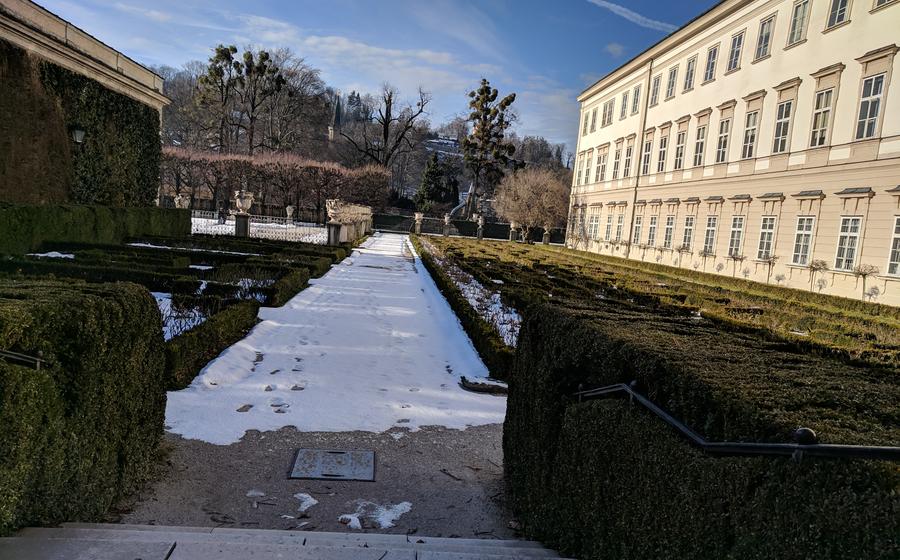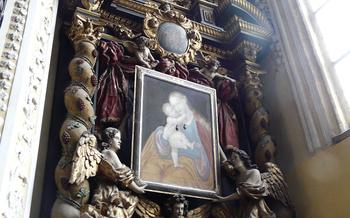
Mirabell Palace and Gardens
- The Mirabell Palace
- The Mirabell Gardens
- The Rose Garden
- The Orangery
- The Dwarfs' Garden
- The Hedge Maze
- The Marble Hall
- The Grand Staircase
- The Hall of Mirrors
- The Music Room
- The Chapel
- The Mirabell Museum
- Insider Tip
The Mirabell Palace
In the heart of Salzburg, nestled amidst verdant gardens, stands the magnificent Mirabell Palace, a testament to the grandeur of the Baroque era. Its history is intertwined with the lives of Salzburg's powerful Prince-Archbishops, who commissioned its construction in the 17th century as a summer residence. The palace's name, derived from the Italian phrase "mirabile," meaning "wonderful," aptly reflects its breathtaking beauty and architectural splendor.
Mirabell Palace is a masterpiece of Baroque architecture, showcasing intricate stuccowork, graceful arches, and elegant symmetry. Its façade is adorned with statues representing the four elements, symbolizing the palace's harmony with nature. The lavish interiors, once home to the Archbishop's court, feature opulent state rooms adorned with frescoes, tapestries, and gleaming chandeliers.
Today, Mirabell Palace stands as a UNESCO World Heritage Site, a testament to its cultural significance and architectural excellence. It has been meticulously restored to its former glory and now serves as a popular tourist attraction, welcoming visitors from around the world. The palace's grandeur and historical charm have also made it a favored filming location, notably in the iconic movie "The Sound of Music," where it served as the backdrop for the memorable gazebo scene.
The Mirabell Gardens
The Mirabell Gardens, a masterpiece of Baroque landscape architecture, owe their existence to Prince-Archbishop Wolf Dietrich von Raitenau, who created them in 1606 as a gift to his mistress, Salome Alt. Inspired by the Italian Renaissance gardens, the gardens were designed by Johann Bernhard Fischer von Erlach, a renowned architect of the time.
The gardens are characterized by their symmetrical layout, intricate flower beds, graceful fountains, and numerous sculptures. The central axis of the gardens is defined by a long walkway flanked by hedges, leading from the Mirabell Palace to the Pegasus Fountain. The gardens are adorned with various sculptures, including mythological figures, cherubs, and animals, which add a touch of whimsy and charm to the landscape.
The Mirabell Gardens were once used as a botanical garden for medicinal plants, reflecting the prince-archbishop's interest in science and medicine. Today, the gardens serve as a popular spot for locals and tourists alike to relax, stroll, and admire the beautiful scenery. Visitors can wander through the gardens, enjoying the fragrant roses, the tranquil sound of water features, and the stunning views of the surrounding mountains.
The Rose Garden
The Rose Garden is a highlight of the Mirabell Gardens, boasting over 12,000 roses of various colors and varieties. Its history and significance date back to the 17th century when Prince-Archbishop Wolf Dietrich von Raitenau commissioned its creation as a symbol of love and beauty. The garden features intricate rose beds arranged in geometric patterns, creating a breathtaking display of vibrant colors.
The annual Mirabell Rose Festival, held in the gardens, is a highlight for rose enthusiasts and visitors alike. During this festival, the roses are showcased in their full glory, attracting visitors from around the world. The festival offers a variety of activities, including guided tours, workshops, and exhibitions dedicated to the cultivation and appreciation of roses.
If you're planning a visit to the Mirabell Gardens, make sure to stop by the Rose Garden in June, when the roses are in full bloom, exuding a delightful fragrance that fills the air. The beauty and tranquility of the Rose Garden offer a perfect spot for relaxation, contemplation, and capturing stunning photographs.
The Orangery
The Orangery, nestled within the enchanting Mirabell Gardens, stands as a testament to the opulence and horticultural prowess of the Prince-Archbishops of Salzburg. Constructed in the 17th century, this greenhouse served as a sanctuary for exotic plants, safeguarding them from the harsh winter elements. Its grand design and elaborate ornamentation reflect the wealth and prestige of its former owners.
Today, the Orangery has been meticulously restored to its former glory and serves as a versatile venue for concerts, exhibitions, and cultural events. Its spacious interior, bathed in natural light, provides an elegant and inspiring setting for a variety of gatherings. Visitors can admire the Orangery's architectural beauty, with its graceful arches, intricate carvings, and decorative elements that blend seamlessly with the surrounding gardens.
Step inside the Orangery and be transported to a world of verdant splendor. Exotic plants from far-flung corners of the globe thrive in this carefully controlled environment, creating a lush and vibrant oasis. The air is filled with the heady fragrance of citrus blossoms and the gentle murmur of water flowing from the nearby fountains.
As you wander through the Orangery, take a moment to ponder its historical significance. In the past, this greenhouse played a crucial role in the cultivation of medicinal plants, contributing to the well-being of the local community. Its legacy as a symbol of botanical knowledge and horticultural expertise lives on, inspiring future generations to appreciate the wonders of the natural world.
Whether you're attending a concert, exploring an exhibition, or simply seeking a tranquil haven amidst the bustling city, the Orangery offers an unforgettable experience. Its unique blend of history, architecture, and natural beauty makes it a must-visit destination for anyone seeking a glimpse into the rich heritage of Salzburg.
The Dwarfs' Garden
Within the enchanting realm of the Mirabell Gardens lies a whimsical and unique attraction: the Dwarfs' Garden. This captivating space features 17 life-size dwarf statues, each possessing its own distinct character and expression. Created by the Italian sculptor Francesco Solari in the 17th century, these charming figures have become iconic symbols of the gardens and a beloved attraction for visitors of all ages.
The statues, crafted from Untersberg marble, depict various human characteristics and emotions, inviting viewers to contemplate the complexities of human nature. Some dwarfs appear jovial and mischievous, while others seem contemplative or even melancholic. Their diverse poses and expressions add a touch of humor and intrigue to the garden, creating a sense of wonder and enchantment.
Interpretations of the statues' symbolism vary, but they are often seen as representations of the seven deadly sins or the different stages of life. Others believe they represent the courtiers of Prince-Archbishop Wolf Dietrich von Raitenau, who commissioned the garden's creation. Regardless of their intended meaning, these captivating figures have become an integral part of the Mirabell Gardens' allure, adding a touch of whimsy and charm to this Baroque masterpiece.
The Dwarfs' Garden is a popular spot for children and families to explore and take photos. The life-size statues provide a unique and interactive experience, allowing visitors to engage with the art and create lasting memories. Whether you're a history buff, an art enthusiast, or simply looking for a fun and enchanting experience, the Dwarfs' Garden is a must-see attraction within the Mirabell Gardens.
The Hedge Maze
The Mirabell Gardens offer a unique and exciting attraction for visitors of all ages: the Hedge Maze. Created in the 17th century, this intricate labyrinth of tall, dense hedges provides a fun and challenging experience for those who dare to venture inside.
With its winding paths and hidden corners, the Hedge Maze is a great place to get lost and enjoy a bit of adventure. Visitors can spend hours exploring the maze, trying to find the way out while enjoying the beautiful surroundings.
The challenge of navigating through the maze adds an element of excitement to the experience, making it a popular attraction for both children and adults. Whether you're looking for a fun activity to do with the family or just want to enjoy a unique and memorable experience, the Hedge Maze is definitely worth a visit.
Insider tip: For those who want to make the most of their time in the maze, it's a good idea to bring a map or take a photo of the layout before entering. This can help you keep track of your progress and avoid getting too lost.
The Marble Hall
The Marble Hall, also known as the Great Hall, is a grand and elegant room located within the Mirabell Palace. It is renowned for its impressive size, ornate decorations, and historical significance. Built in the 17th century, the Marble Hall served as a venue for important events and ceremonies, including grand receptions, balls, and official functions.
The hall's architectural features are simply stunning. Its walls are adorned with exquisite marble columns, intricate carvings, and beautiful frescoes depicting mythological scenes and historical events. The high ceiling is adorned with a magnificent chandelier, adding to the room's grandeur.
Throughout history, the Marble Hall has witnessed countless significant moments. It was here that Prince-Archbishops received distinguished guests, held lavish banquets, and made important decisions that shaped the fate of Salzburg. The hall's grandeur and opulence reflect the power and prestige of the Archbishops who resided in the Mirabell Palace.
Fun Fact: The Marble Hall was used as a filming location for the acclaimed movie "Amadeus," which tells the story of the legendary composer Wolfgang Amadeus Mozart. The hall's opulent setting provided a fitting backdrop for scenes depicting the grandeur of the Archbishop's court.
The Grand Staircase
The Grand Staircase of the Mirabell Palace is a breathtaking architectural masterpiece that connects the different floors of the building. Ascending or descending this magnificent staircase is an experience in itself, as visitors are greeted with intricate carvings, sculptures, and beautiful ceiling frescoes.
The staircase was designed with great attention to detail, featuring elaborate balustrades, ornate newel posts, and graceful curves. The walls are adorned with frescoes depicting scenes from mythology and history, adding to the grandeur of the space.
Historically, the Grand Staircase served as a symbol of power and prestige, as it was used by the Archbishop of Salzburg and his guests to make grand entrances and exits. Today, it continues to impress visitors with its elegance and opulence, making it a popular spot for photo opportunities and a reminder of the palace's rich past.
Insider tip: Take a moment to admire the beautiful ceiling frescoes while ascending or descending the staircase. These works of art, created by talented artists of the time, depict various scenes and add to the overall grandeur of the space. Don't miss the opportunity to appreciate the intricate details and symbolism hidden within these stunning paintings.
The Hall of Mirrors
The Hall of Mirrors is a stunning room in the Mirabell Palace, featuring a series of large mirrors that reflect the room's grandeur and elegance. Built in the 18th century, the hall was designed to impress visitors with its opulent décor and spaciousness. The walls are adorned with intricate carvings and gilding, while the ceiling features a magnificent fresco depicting mythological scenes. The Hall of Mirrors was used for grand receptions, celebrations, and balls, showcasing the wealth and power of the Archbishop of Salzburg. Today, it is a popular venue for weddings, concerts, and other special events.
Fun fact: The Hall of Mirrors is often used for weddings and other special events, creating a magical and unforgettable atmosphere for guests.
The Music Room
Within the walls of the Mirabell Palace, a space is dedicated to the harmonious melodies of music—the Music Room. This magnificent chamber has witnessed countless musical performances and concerts throughout history, its walls resonating with the talents of renowned musicians and composers.
The Music Room's architectural design is a testament to its musical purpose. Its exceptional acoustics, achieved through careful planning and construction, ensure that every note reverberates with clarity and perfection. The room's elegant décor, with its intricate carvings and tasteful adornments, creates an ambiance that is both inviting and inspiring.
One of the most captivating anecdotes associated with the Music Room is the presence of Wolfgang Amadeus Mozart, one of history's greatest musical prodigies. Within these walls, Mozart showcased his extraordinary talent, captivating audiences with his compositions and performances. His music filled the room, leaving an indelible mark on its history.
Today, the Music Room continues to serve as a venue for musical excellence. Concerts and recitals are held regularly, allowing visitors to experience the magic of live music in this extraordinary setting. Attending a performance in the Music Room is a journey through time, transporting listeners back to the era of Mozart and other musical luminaries who graced this hallowed space.
The Chapel
Within the sacred walls of the Mirabell Palace, a spiritual haven awaits discovery—the Chapel. This consecrated space, steeped in history and devotion, beckons visitors to immerse themselves in its serene atmosphere. Here, amidst intricate stained glass windows that cast a kaleidoscope of colors, and an ornate Baroque altar that exudes a sense of grandeur, one can find solace and connection with the divine. Whether attending a traditional religious service or simply seeking a moment of quiet contemplation, the Chapel offers a sanctuary for the soul. Fun fact: The Chapel is not just a place of worship but also a popular venue for weddings and baptisms, where couples exchange vows and families celebrate the joyous milestones of life, creating memories that will last a lifetime.
The Mirabell Museum
The Mirabell Museum is a must-visit destination for anyone interested in delving deeper into the history and cultural significance of the Mirabell Palace and Gardens. Established in 2007, the museum is housed within the palace's former stables and features a range of exhibits and displays that provide a comprehensive overview of the site's rich past.
Visitors to the museum can learn about the palace's construction in the early 17th century by Prince-Archbishop Wolf Dietrich von Raitenau, as well as its subsequent use as a summer residence for the prince-archbishops of Salzburg. The museum also sheds light on the development of the gardens, from their initial creation as a Renaissance-style pleasure garden to their transformation into a Baroque masterpiece under the direction of Johann Bernhard Fischer von Erlach.
Exhibits at the Mirabell Museum include historical documents, paintings, sculptures, and artifacts that offer a glimpse into the daily life and activities of the palace's former occupants. Visitors can also learn about the role of the Mirabell Palace and Gardens in Salzburg's cultural and social history, including their use as a venue for concerts, festivals, and other events.
To enhance the visitor experience, the Mirabell Museum offers a variety of interactive exhibits and educational programs. Guided tours are available to provide in-depth insights into the palace's history and architecture, while hands-on activities and workshops allow visitors to engage with the museum's collection in a fun and interactive way.
For those seeking a deeper understanding of the Mirabell Palace and Gardens, a visit to the Mirabell Museum is an absolute must. The museum's informative exhibits and engaging programs offer a unique opportunity to explore the rich history and cultural significance of this iconic Salzburg landmark.
Insider Tip: Check the museum's website for information on special exhibitions and events. The museum often hosts temporary exhibitions that focus on specific aspects of the palace's history or the work of renowned artists who have been associated with the site. These exhibitions offer a fresh perspective on the Mirabell Palace and Gardens and are a great way to learn more about this cultural treasure.
Insider Tip
To experience the Mirabell Palace and Gardens in all their glory, plan your visit during the renowned Salzburg Festival, which takes place every year in July and August. This prestigious festival transforms the city into a vibrant cultural hub, offering a diverse program of world-class performances in opera, theater, and music. The festival's magical atmosphere, coupled with the stunning backdrop of the palace and gardens, creates an unforgettable experience for visitors.
Insider Tip: To secure your spot at these highly sought-after events, book your festival tickets well in advance. The Salzburg Festival website provides detailed information on the festival program, ticket prices, and availability. Don't miss this opportunity to immerse yourself in the vibrant arts scene of Salzburg and create lasting memories in this enchanting city.









